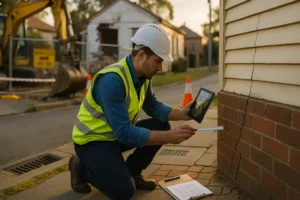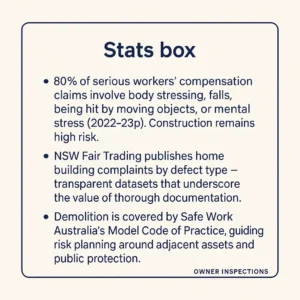Why Dilapidation Reports Are Essential Before Demolition

Do I Really Need a Dilapidation Report Before Demolition?
Yes. In NSW, a pre-construction dilapidation report is commonly a standard condition of development consent and councils typically require a matching post-construction report. In Victoria, demolition often triggers Section 29A Report & Consent, and where protection works apply, a Section 94 survey of adjoining property (i.e., a dilapidation record) is expected before works. These reports reduce dispute risk and help you meet legal and council obligations.
What you’ll learn:
- What a pre-demolition dilapidation report covers and who pays
- When it’s required in NSW and VIC (with direct references)
- How the workflow runs before and after demolition
- What inspectors document (and why independence matters)
- Compliance cheat-sheet, costs, tips, and FAQs
What is a Dilapidation Report?
A dilapidation report (also known as a pre-construction condition report or adjoining property survey) records the existing condition of neighbouring structures and public assets before demolition or excavation. It provides photo evidence and notes on cracks, movement, finishes, and site features, so any changes can be identified after the works. Typical coverage includes interiors and exteriors, fences, driveways, retaining walls, outbuildings and council assets such as kerbs and footpaths.
- Who pays? Usually the builder/developer (the party undertaking the works).
- When used? Before demolition, excavation or protection works.
- What happens after? A post-demolition inspection compares conditions and documents any change.
Is it Required Before Demolition? (AU by State)
NSW
Most residential consents include a dilapidation report condition before any site work commences, prepared by a suitably qualified professional and accepted by the principal certifier (PC) or council. Where neighbours refuse access, councils accept an external-only survey plus proof of reasonable attempts to obtain access. Copies must be provided to adjoining owners and to council within the nominated timeframe. Many consents also require a post-construction dilapidation report before the Occupation Certificate is issued.
NSW’s standard conditions program confirms councils should use these standard consent conditions under the EP&A Act (Part 4), which is why you’ll often see the same wording across LGAs.
Note on the principal certifier (PC): The PC is an independent regulator who inspects building work and ensures compliance; they are not your builder or site supervisor.
Victoria
Demolition commonly triggers Section 29A Report & Consent from the responsible authority (usually council) before a building permit for demolition is issued. Guidance from the Victorian Building Authority and the state planning guides set out timing and the tests (e.g., more than half the volume; street-facing façade).
Where protection works apply, the Building Act provides for a Section 94 “survey of adjoining property” (a signed record of pre-existing condition) and rights of entry to carry out the survey and works. Councils like the City of Melbourne also describe the Section 29A process for proposed demolition.
Why it Matters Before Demolition
Demolition can generate vibration & ground movement, dislodge debris and stress older structures. Without a baseline, minor pre-existing cracks can turn into major disputes. A clear report helps you:
- Prove compliance with development consent or building approvals
- Reduce dispute risk with neighbours and insurers
- Support safety planning alongside your SWMS and demolition method statements

What Inspectors Document
Expect photo-rich, geo-tagged records of: wall and ceiling cracks; masonry/render; roof and gutters; windows/doors; driveways, crossovers and paths; fences and retaining walls; sheds/outbuildings; pools/spas; and council assets (kerbs, footpaths, pits, street trees). Good reports include crack measurements, sketch plans, and clear location references so a post-demolition inspection can be aligned easily.
Tip: Use independent, licensed inspectors who are separate from your builder or demolition contractor to avoid conflicts.
Step-by-step: Pre- and Post-demolition Workflow
Before Works
- Book early (7–14 days out) and brief your inspector on scope, neighbouring lots and council assets.
- Notify neighbours to arrange access—document attempts in writing.
- Conduct the inspection: interiors (where permitted), exteriors and public assets.
- Deliver the report to neighbours and to council/PC if required (NSW consents often specify timing).
- File & share with your builder/demolition contractor and keep it accessible during works.
After Demolition
- Re-inspect the same areas using the same routes and angles.
- Compare with the baseline and flag any change.
- Resolve: If change is attributable to your works, the evidence shortens the path to a fair outcome.
- Submit the post-construction dilapidation report if your consent requires it (NSW often before the Occupation Certificate).
NSW & VIC Compliance Cheat-sheet
|
Trigger |
What council/legislation expects |
Document |
When due |
Who to send to |
|
NSW: Before site work commences |
Standard consent conditions typically require a pre-construction dilapidation report, prepared by a suitably qualified professional. If access is refused, do an external-only survey and show reasonable attempts for access. |
Pre-construction dilapidation report |
Before any site work (timing per consent) |
Adjoining owners and council/PC |
|
NSW: Before occupation |
Many consents require a post-construction dilapidation report to confirm any change vs the baseline. |
Post-construction dilapidation report |
Before the Occupation Certificate (as specified) |
Council/PC and adjoining owners |
|
VIC: Demolition |
Section 29A Report & Consent often needed before a demolition permit; responsible authority usually the council. |
s29A Report & Consent |
Prior to demolition permit |
Council (responsible authority) |
|
VIC: Protection works |
Where protection works apply, Section 94 survey of adjoining property (dilapidation record) is part of the process; provides entry rights for survey/works. |
s94 Survey (adjoining property condition) |
Before works that risk adjacent damage |
|
|
VIC: City of Melbourne example |
Council explains when s29A consent is needed for proposed demolition. |
s29A consent guidance & forms |
At application |
City of Melbourne (forms provided) |
Who Should Do It (And Why Independence Matters)
Choose an independent inspection firm. Your principal certifier (NSW) or relevant building surveyor (VIC) has regulatory duties and cannot act as your advocate; their role differs from the inspector who documents condition for comparison. Shortlist providers with:
- Professional indemnity & public liability insurance
- Sample reports (look for clear photos, measurements, plans)
- Fast turnaround (24–48 hours is realistic)
- Coverage across NSW, VIC and QLD
Cost, Riming & Tips
Costs vary with property size, number of neighbours, access constraints and whether council assets are included. Where a neighbour won’t grant access, document reasonable attempts (emails/letters) and proceed with an external-only survey—this still satisfies many NSW consent conditions when properly evidenced. Schedule 7–14 days before demolition, allow time for access, and copy all stakeholders (builder, demolition contractor, PC/building surveyor, and council if listed in your consent).
Builder & Neighbour Playbooks
Builder / PCBU checklist:
- Notify early; include method statements and site contacts
- Keep Safe Work code guidance in mind for planning and public protection controls
- Confirm report circulation and sign-offs before site mobilisation
Neighbour checklist:
- Grant access (it protects you too)
- Keep a copy of the report
- Photograph fragile items/valuables before works start
Book Your Pre-demolition Dilapidation Report
Protect your project and your neighbours. Book an independent dilapidation report before demolition with Owner Inspections. Our certified inspectors deliver impartial, photo-rich reports within 24–48 hours, covering interior, exterior and council assets—so you’re compliant, documented and dispute-ready across NSW, VIC and QLD. Get a fixed quote and schedule today.
| Learn more about our service.
